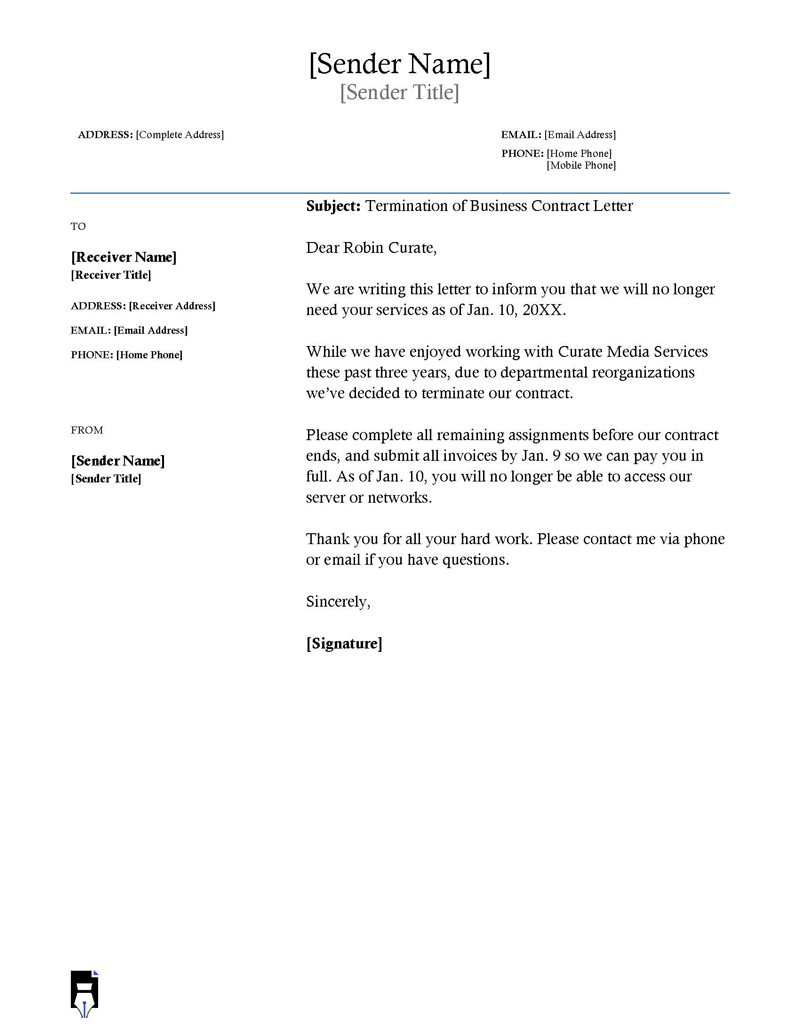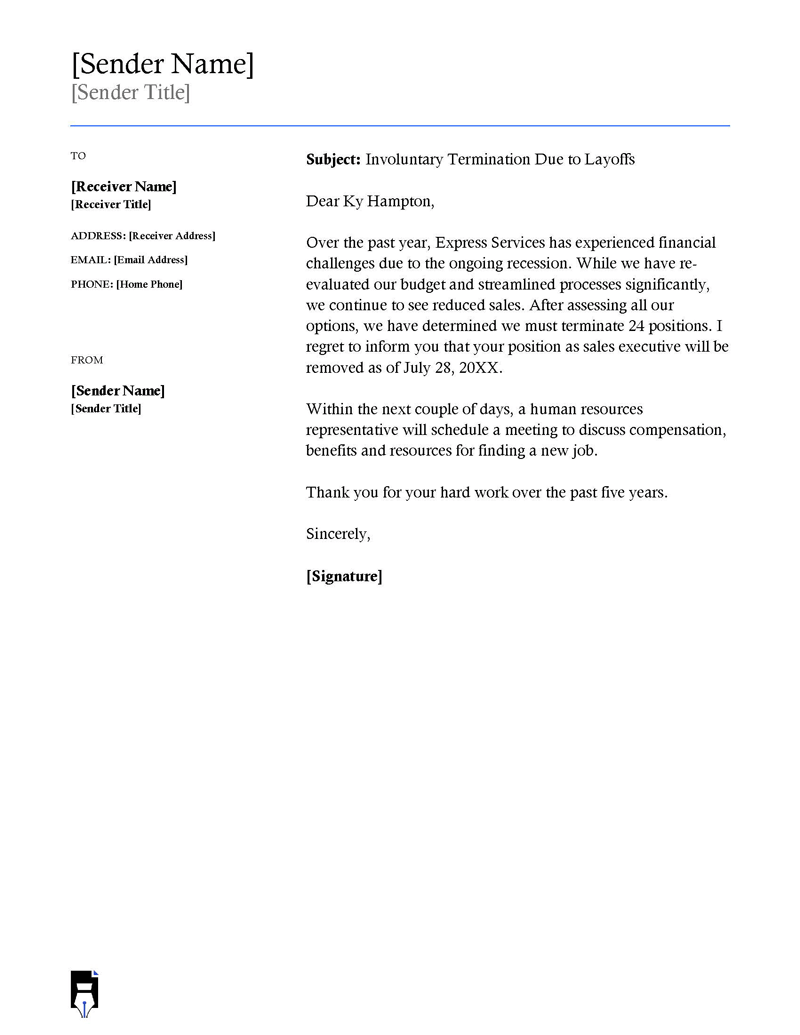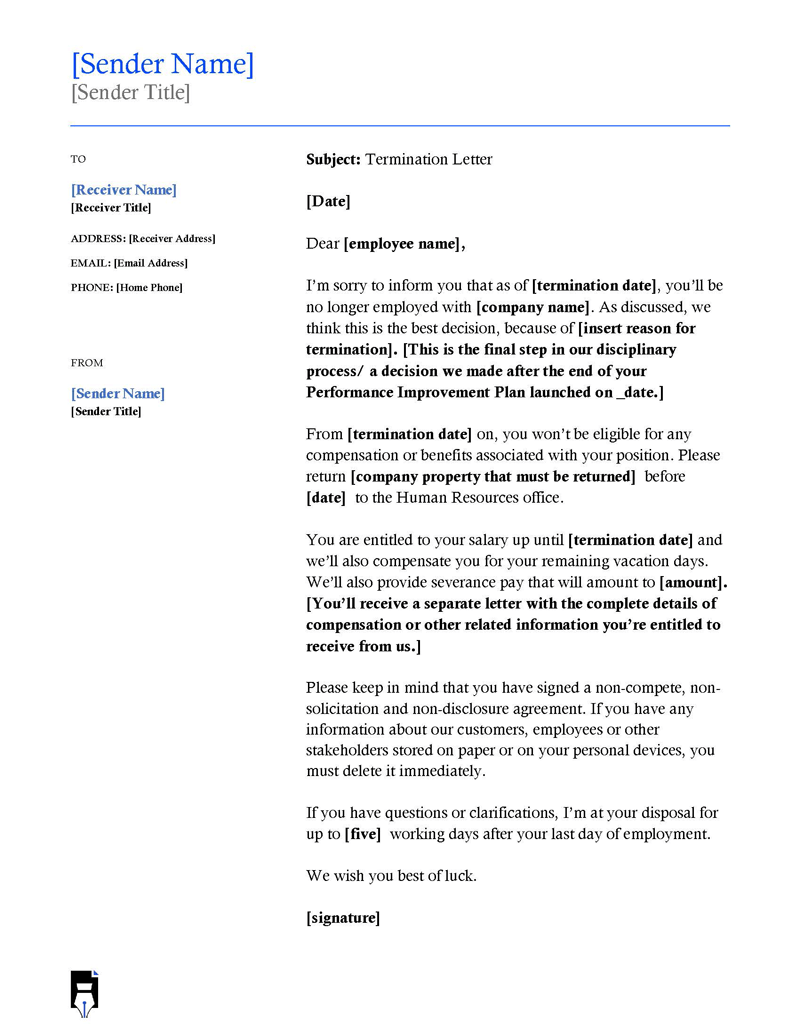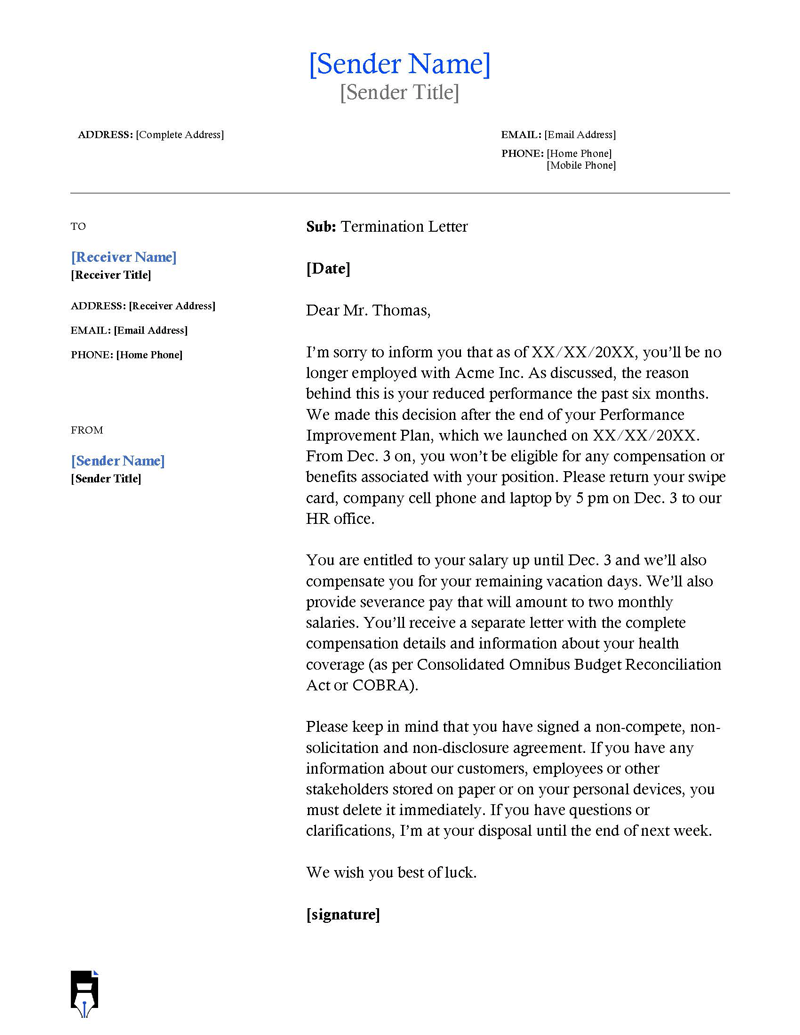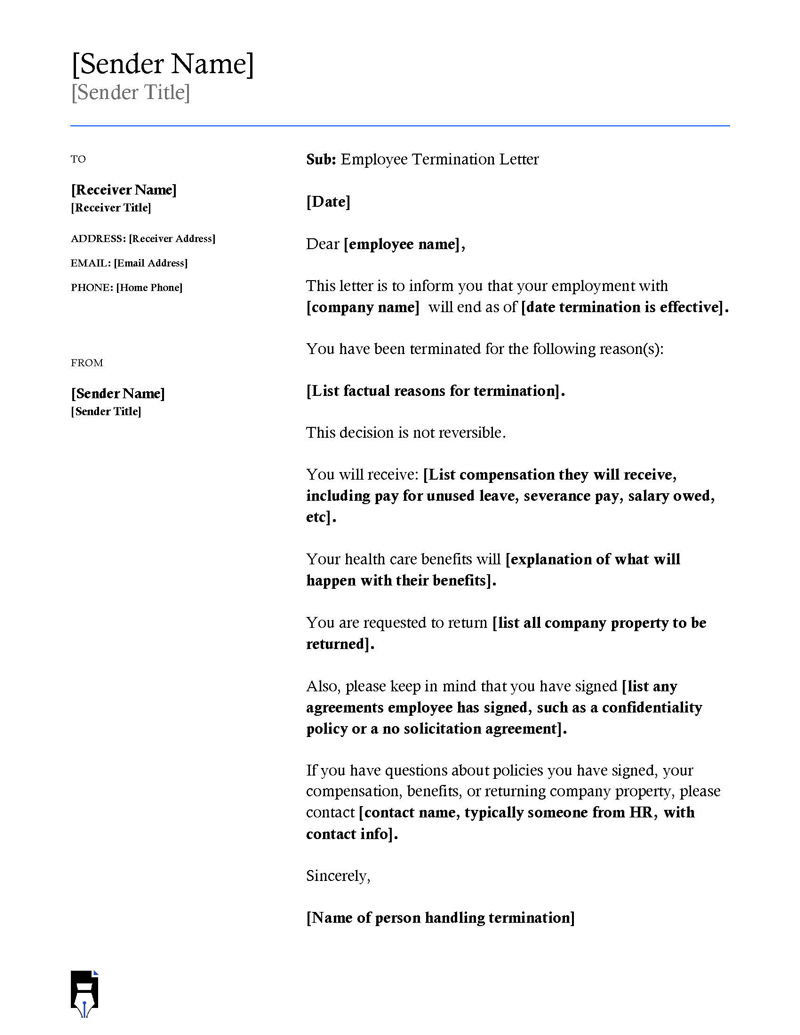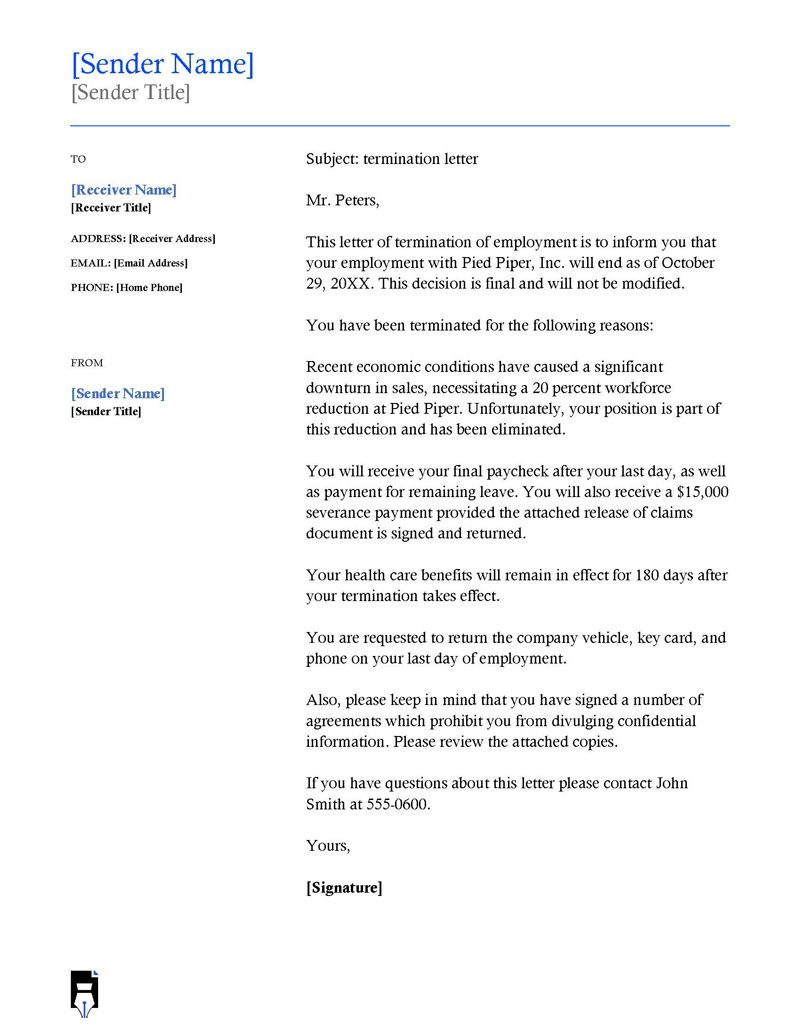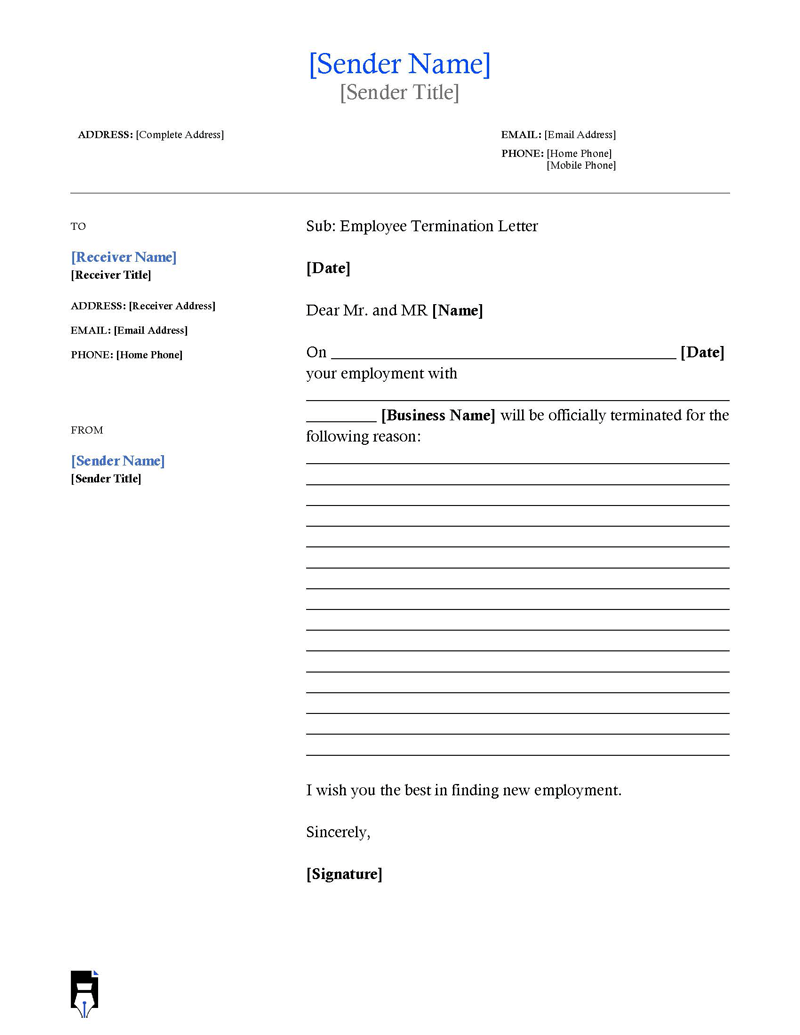As an employer of a company, there comes a time when you might need to terminate an employee’s job. It is vital to deal with such matters professionally by using a document describing the separation between you as the employer and the employee. In addition, you will need to prepare a termination letter to inform the employee of the job termination, highlight the reasons for the termination and provide guidance on the next steps they need to follow.
Letting someone go, especially in a professional setup, requires using the termination letter. Since that is the case, you can use this article to fully understand what a letter of termination is, how to write it and what you should include in the letter. Keep in mind that it is more polite to use this letter when terminating your employee’s job as it provides a proper structure and prevents disputes.
What is a Termination Letter?
A termination letter is an official letter prepared by either an employer or a company to notify an employee that their job has been terminated.
In other words, this letter is meant to tell your employee that you have fired them from their job position. It is usually prepared using a template that you will use as a guide to include the appropriate information regarding the job termination.
With a template, you will have predetermined areas where you will be required to include the necessary information, such as the employee’s identity and address. You will also need to inform the employee of the reason(s) for the termination, the next steps they will need to follow, the compensation expected, the benefits they will receive, the date of their final paycheck, and other essential termination details.
Alternative names
Here are some alternative names for a termination letter:
- A letter of separation: A document that states that an employee’s tenure with the company is over.
- A pink slip: A written notice of employment termination that is usually printed on pink paper.
- A letter of termination: A formal notification of an employee’s job termination that outlines the reasons for the termination.
- A contract termination letter: A letter used to end a contractual relationship between an employer and an employee.
- A notice of termination of employment: A formal notice that an employee’s employment is ending, which outlines the reasons for the termination.
Termination Letter Templates
You can download the following templates for free:
Reasons for Terminating an Employee
Employment termination is a process that involves ending an employee’s job at a company. Termination can be voluntary or involuntary and falls under the following two categories:
Voluntary Termination
Under this category, the employee may choose to resign, retire or leave the company after they complete their contract. In this case, the termination letter will finalize the job termination process, and the employee will leave their job.
Involuntary Termination
Involuntary termination involves dismissing an employee with or without cause. For termination due to cause, the employee may have committed offenses such as contract violations, illegal actions, poor behavior, neglecting job duties, etc. In such cases, employers must follow appropriate procedures to ensure that the termination is legal and ethical. For termination without cause, the employee’s services are no longer required, such as during layoffs or furloughs.
Employers must follow legal and ethical considerations when terminating an employee. Involuntary termination, in particular, can have serious consequences for both the employee and the employer. Employers should consult with legal professionals to ensure compliance with labor laws and regulations and provide the necessary support to employees affected by involuntary termination.
Employment Contract Vs. At-Will
When terminating an employee’s job, employers must consider the employee’s employment status, whether they are under an employment contract or at-will employment.
For employees under an employment contract, employers must follow the terms and conditions outlined in the contract. In some cases, employers may terminate an employee’s job before the contract period ends discreetly, while in other cases, employers may terminate an employee’s job for reasons such as poor performance or a violation of the contract. In some cases, employment contracts may prevent employers from terminating an employee’s job, no matter the circumstances.
For employees under at-will employment, employers can terminate their job for any reason, at any time, and without notice. However, employers must adhere to local labor laws and regulations when terminating an employee’s job to avoid violating required legal procedures.
Employers must also consider the legal and ethical considerations that come with terminating an employee’s job under different employment statuses. Terminating an employee’s job in violation of labor laws or regulations can have serious consequences for both the employee and the employer. Employers should consult with legal professionals to ensure compliance with labor laws and regulations and provide the necessary support to employees affected by involuntary termination.
Procedure to Terminate an Employee
Terminating an employee is a challenging process that must be handled professionally and respectfully. Below is a guide on how to approach the termination process, including the necessary steps and procedures that you should observe:
Identify the reason for termination
The first step in the termination process is to identify the reason for terminating the employee’s employment. It is crucial to meet with the HR department to discuss if the reason is fair and to avoid wrongful termination lawsuits. You should also gather all evidence and documents supporting your reason for termination, such as performance reviews and supervisor warnings.
Meet with the employee
The next step is to schedule a meeting with the employee to discuss their pending termination. The meeting should be held in a private place away from the rest of the employees, and an HR representative should be present. It is advisable to schedule the meeting early in the week to allow the employee to prepare for their departure and even start searching for a new job.
Choose a day to terminate
After meeting with the employee, you should choose a day to terminate their employment. It is preferable to terminate them at the beginning or middle of the week to give them enough time to start their search for a new job. For employees with erratic behavior, it is best to terminate them on Friday at the end of the workday to prevent any work disruption.
Provide adequate notice
It is essential to provide the employee with adequate notice before terminating their employment. For example, if the termination is polite and pleasant, it is advisable to give the employee a two-week notice to train the new employee. However, for a hostile employee, the termination should be immediate to avoid any further damage.
Write a termination letter
Once you have chosen the termination date, you must write a termination letter that contains all the information the employee needs regarding their employment termination. It is advisable to have the company’s lawyer or the HR department review the letter before giving it to the employee.
Provide compensation information
You must provide the employee with compensation information, including the payroll and benefits they will receive after the termination. Ensure that you mention if the final payroll includes severance pay, and provide information about health insurance and retirement benefits. These benefits should be terminated or transferred to their new employer if applicable.
Escort the employee
Proceed to escort the employee off the company property if their termination is immediate due to severe misconduct or wrongful actions.
Break the news to the company
You should inform the company of the employee’s termination without sharing private details. The employees and staff need to hear from you about the employee’s departure and the company’s plans to move forward without them. You should also notify them of the company’s plans to replace the employee.
Arrange Employee Documents
Finally, you should arrange or organize the employee’s documents, including copies of their termination records and the termination letter. This is important, especially if the employee decides to take legal action against you or the company.
Factors to Pre-Consider
Before firing an employee, there are factors that you need to consider to avoid any legal issues. These factors are essential in ensuring that you follow the relevant terms and uphold the state’s regulations regarding employment termination.
Consult with a lawyer
Before terminating an employee, it is essential to consult your lawyer to determine if you are legally allowed to do so. Your lawyer will advise you on the relevant terms that you must uphold based on your state, such as providing enough notice, providing reasons for termination, and paying the employee the severance fee. This consultation will help you avoid any potential lawsuits that may arise from wrongful termination.
Choose the last day of work
You need to choose the last day that the employee will be at work before the termination happens. This will give you enough time to prepare for their departure and allow them to prepare for their future. You should also include all the policies that the fired employee should observe, in the letter, once their employment has been terminated.
Use a termination letter template
Using a template and sample letters to guide you as you write the termination letter is best. However, ensure that you customize the letter to ensure your tone is sensitive and appropriate. This will ensure that the termination process is professional and respectful.
Information to Include
Terminating an employee is not an easy task, but it can be necessary for the health of your business. Once you understand the procedures for terminating an employee properly and legally, the next step is to focus on the termination letter. A complete and adequate termination letter is crucial to ensure that the termination is handled professionally, legally, and in a sensitive manner.
Here is a breakdown of the information that you should include in your termination letter:
- The company’s name: It is essential to mention the name of your company at the beginning of the letter to ensure clear identification.
- Employer’s name: As the employer issuing the job termination, include your name in the letter.
- The letter’s date: Include the date on which the letter was prepared for the employee regarding their work termination.
- The employee’s name, title, and department: Include the employee’s name, title, and department as part of the address.
- The termination date: Mention the termination date in the body of the letter to allow the recipient to know the purpose of the letter.
- The reason for termination: Your letter must include the reasons why you are firing the employee. Always maintain a professional and sensitive tone while describing this section, whether the reason falls under the voluntary or involuntary category.
- List of evidence or warnings that led to the employee’s dismissal: Provide a list of evidence or warnings that support your claim regarding the employee’s dismissal. This may include performance reviews and records of warnings from colleagues or a supervisor.
- Items the employee must return to the company: If applicable, instruct the employee to return all items that belong to the company and remind them to complete their tasks and handle any pending projects for an easier replacement transition.
- Specify the employee’s last paycheck, vacation pay, severance packages, and benefits: Include and specify when employees will receive their last paycheck, vacation pay, severance packages, and benefits.
- Any nondisclosure, non-compete, or other agreements the employee signed: If there are any nondisclosure, non-compete, or other employment agreements that the employee signed, mention and highlight the agreed-upon terms and conditions that focus on the job termination.
- H.R. Contact Information: Include the contact information, such as phone number or email address, of the H.R. department to make it easier for the employee to reach out in case they need help, clarifications, or have questions.
Termination Letter Template
[Company’s Name]
[Employer’s Name]
[Letter’s Date]
[Employee’s Name]
[Employee’s Title]
[Employee’s Department]
Dear [Employee’s Name]
This employment termination letter is meant to inform you that your services as an employee will no longer be required as of [termination date].
We truly enjoyed working with you but based on [the reason for termination], the company has decided to let you go. This decision was made based on your [evidence or warnings attributed to the termination]. Therefore, ensure that you [instructions for the employee] and return [name the items] to the company by [termination date].
Please complete any pending work by [provide a date] to ensure you receive your [specify the employee’s last paycheck, vacation pay, severance packages, and benefits] by [mention a date]. All this is based on the [mention any nondisclosure, non-compete, or other agreements the employee signed].
If you need any clarifications or have any questions, please contact [H.R. contact information] for help.
Best of luck!
Sincerely
[Employer’s Name]
Title]
Letter of Termination Samples
Given below are two samples of termination letter:
Sample 1
[Employer’s Company Name and Address] [Date]
[Employee’s Name] [Employee’s Department]
Dear [Employee’s Name],
We regret to inform you that your employment with [Employer’s Company Name] will be terminated effective [Termination Date].
As per our previous discussions, we acknowledge the terms of your employment contract and other agreements made with the company. We kindly request that you return all the company’s equipment and complete any pending tasks. We also request that you organize any assignments or projects to make it easier for your successor.
We appreciate your dedication and hard work during your tenure at [Employer’s Company Name]. We will provide you with your last paycheck, including vacation pay, severance packages, and other benefits, on [Date of Final Paycheck].
If you have any questions or clarifications, please do not hesitate to contact the H.R. department at [H.R. department email address].
Thank you for your service to [Employer’s Company Name], and we wish you all the best in your future endeavors.
Sincerely, [Employer’s Name] [Employer’s Title, Company Name]
Example 2 (Involuntary, for example, Bad performance)
[Date]
[Employee Name]
[Job Title]
[Department]
Dear [Employee Name],
This letter is to inform you that your employment with [Company/Hospital Name] has been terminated with immediate effect.
Your performance at work has been below the expected standard, leading to this difficult decision by the hospital. Despite several warnings and trainings provided to improve your performance, your lateness and neglect of duties have continued to be a cause for concern. As a result, we regret to inform you that your services will no longer be required at [Company/Hospital Name].
Please ensure that you return all hospital equipment to the [Department] and sign all necessary documents before leaving the premises. Your final paycheck, severance pay, and any other benefits owed to you will be calculated and processed within a month after your termination date.
We advise that you withdraw from all nursing duties and adhere to the instructions outlined in this letter. If you have any questions, please contact the H.R. department at [H.R. department phone number].
We appreciate your efforts during your time with us and wish you all the best in your future endeavors.
Sincerely,
[Head Nurse Name]
[Job Title]
[Department]
Note: Avoid discrimination. As an employer or company, it is essential to avoid discrimination regarding employment termination. State and federal labor laws prohibit work termination based on discriminatory reasons such as age, gender, gender identification, race, religion, national origin, pregnancy status, sexual orientation, and disability. Such scenarios may lead to wrongful termination lawsuits from the employee(s). Ensure you consult a lawyer to avoid discriminatory circumstances that might cause you to face penalties, sanctions, or fines if found guilty.
Frequently Asked Questions
Are termination letters required?
According to the law, termination letters are required in some States, such as Arizona, California, Illinois and New Jersey. However, most companies are not required to provide their employee(s) with this letter when terminating their employment. Instead, companies and employers give their employees this letter as a sign of professional courtesy to have a legal record of the separation and enable them to apply for unemployment benefits.
What’s the required termination notice period?
According to U.S. labor laws, the required termination notice period is either based on the employment contract or the minimum notice period required by employees under a union. It is best to provide 60 days’ notice if you are closing the company or laying off some people.
Do I have to give an employee a termination letter?
You do not have to give your employee a termination letter as no federal law requires you to do so. Whether it is an at-will or contract employment, you can choose to provide a letter of termination to your employee or not.
Does an employee need to sign a termination letter?
An employee does not need to sign the termination letter. However, signing or failure to do so does not affect the termination.
Is discharge the same as termination?
These two terms may be used interchangeably in some instances. However, discharge means that the contract’s requirements have been met in terms of an employment contract. The relationship between an employer and an employee has come to an end. At the same time, termination not only focuses on the end of the contract but can also mean separation between the employer and employee due to a breach or violation of the contract by the employee.
